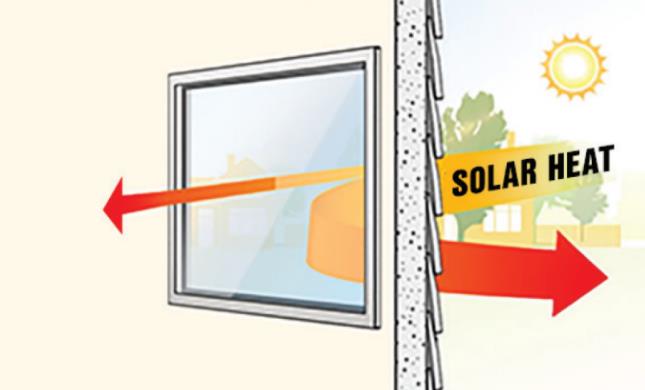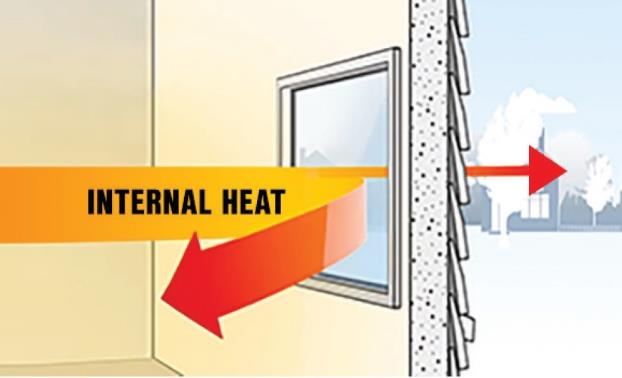Store Location: 114 Holloway Road, Aro Valley, Wellington, Wellington
info@oceanicglassinnovations.com
+6498899268
Head Office: 83 Rushdale St, Knoxfield VIC, 3180, Australia
+61 485 814 909
To understand how LowE coated glass works, we must understand the basics of heat transfer…
Heat wants to go from where it is hot to where it is not. When it is hot outside, heat derived from the sun wants to come inside – we call this Heat Gain. When it is cold outside, heat from inside our buildings wants to go out – we call this Heat Loss.
Heat will find the path of least resistance to travel from ‘hot to not’ and in a building with brick walls and aluminium windows, the clear glass and the frame material is the path of least resistance as regular clear glass and standard aluminium are both great conductors of heat – meaning heat can pass through it very easily.
Think of Heat as two main types:
Heat from the Sun, also known as ‘Solar Heat’ and ‘Passive Heat’.
The factor here being Solar Control – how much heat from the Sun comes into our building and therefore, how much is blocked.
This can be measured by the Solar Heat Gain Coefficient (SHGC).


Also known as Conductive and Convective Heat, it is all other heat including; body heat, heat from oil heaters, electric heaters, air conditioning units, fire places…
.
The factor here being Insulation – how much heat we retain when it is colder outside.
This can be measured by the U-Value.
| Type #1 Heat | Type #2 Heat |
|---|---|
| Heat from the Sun | All other Heat |
| aka. Solar Heat, Passive Heat | aka. Convective Heat, Conductive Heat |
| Factor: Solar Control | Factor: Insulation |
| Measured by: SHGC | Measured by: U-Value |
The two types of heat are different by their electromagnetic wavelength signatures. Relevant radiation particles that we receive from Type #1 Heat of the Sun are Visible Light, Ultraviolet Light, and Infrared. It is the Infrared particles that contain the heat factor...
This is how a single glazed Grey Tinted glass can block high levels of Visible Light, UV, and Infrared Heat...
By using Clear glass in Double Glazed Units (DGU), you affect the conduction properties of the glass for longer wavelength Type #2 Heat...
This is how a single glazed Grey Tinted glass can block high levels of Visible Light, UV and Infrared Heat, but have little effect on Type #2 Heat, in fact the exact same effect that regular single glazed Clear glass offers.
By using Clear glass in a Double Glazed Units (DGU), you affect the conduction properties of the glass for longer wavelength Type #2 Heat by stopping a lot more of the longer wavelength heat from escaping while still allowing shorter wavelength Light and Infrared heat from the Sun to enter inside. It is the encapsulated air gap that allows such performance against Type #2 Heat and this is why a regular DGU with clear glass has significantly better Insulation properties than any single glazed option, including single glazed Hardcoat LowE coated glass. Adding argon gas in that air gap adds further Insulation properties (lower U-Value) by stopping more longer wave Type #2 Heat from passing through and all AGG Insulglass® IGU products come with argon gas as standard (may exclude some specialised sizes).
This is also how a LowE coated glass in a DGU offers the best options in multiple performances; either a Clear LowE (eg. Insulglass LowE Plus®) that allows Light and Infrared Heat from the Sun inside but blocks significant levels of Type #2 Heat from escaping – an ideal solution for colder climates. Or a Solar Control LowE (eg. Insulglass LowE Max®) that covers all factors, allowing healthy levels of Light to enter inside but blocks significant levels of infrared Heat from the Sun heat from entering, while also stopping significant levels of Type #2 Heat from escaping – an ideal solution for Commercial buildings or Residential buildings in warm-hot climates.
A helpful acronym here is Reflection, Absorption & Transmittance (R-A-T).
When looking at Type #1 Heat from the Sun, this heat travels in one direction, predominantly from the sun to the inside of our buildings via the glazing (the path of least resistance compared to a brick wall). When 100% of the heat reaches the window, instantly some of that heat is Reflected away, of the remaining energy some gets Absorbed by the glass and framing and the rest Transmits all the way through. R + A + T = 100% of the original heat.
When looking at Type #2 Heat generated inside a building on a cold day or night, this heat travels to the window wanting to escape. This heat will also follow the Reflection, Absorption, and eventual Transmittance pattern.
Different glass and different framing material will have different ratios of Reflection and Absorption of heat, which both affect the end Transmittance value. The same window will also have different performances against Type #1 Heat versus Type #2 Heat. The glass type that offers the best values and best balance of both, is LowE coated glass. The frame material type that offers the best values are; Thermally Broken Aluminium, Timber, uPVC or composites using a combination of materials acting as a thermal break.
Tinted glass (eg. Grey Tint) has a higher Absorption of Type #1 Heat compared to regular float glass but has the exact same effect of Type #2 Heat… which is minimal affect.
Clear LowE coatings (eg. Insulglass LowE Plus®) have better Reflection and Absorption of type #1 Heat compared to regular float glass but is still allows high levels of Transmitted Type #1 Heat from the Sun inside…. And at the same time, it has excellent Reflection of Type #2 Heat for advanced Insulation… which is the desired set of performance for colder climates.
Solar Control LowE coatings (eg. Insulglass LowE Max®) have a great balance of both Reflection and Absorption of Type #1 Heat… and also significant Reflection of Type #2 Heat making it an ultimate solution and ideal for Commercial buildings and Residential buildings in warm-hot climates.
Get In Touch With Us
info@oceanicglassinnovations.com
+6498899268
+61 485 814 909